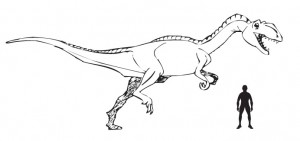Happy Australia Day! A Tribute to Australian Dinosaurs
January 26th – Australia Day A Tribute to Australian Prehistoric Animals
Australia Day is celebrated on January 26th each year. It is a public holiday throughout the country as Australians celebrate all that is great and good about their unique country. Although, only adopted fairly recently as a national holiday, there has been a tradition of celebrating on January 26th right back to the earliest times of settlement by Europeans.
The date marks the first landing of the British convict ships in 1788 at Sydney Cove and the raising of the Union Jack flag over this part of the territory.
Australian Dinosaurs
Australia has been the focus of extensive palaeontological interest in recent years as this huge continent is explored for fossils. A number of dinosaurs are known from this part of the world, along with a number of other prehistoric animals including marine reptiles such as the pliosaur Kronosaurus. Kronosaurus was not a dinosaur but a short-necked plesiosaur (termed pliosaur). This huge carnivore swam around a shallow sea (now Queensland) in the Early Cretaceous. Estimates as to the size of this animal vary but most scientists state the this animal was up to 10 metres long, with a head making up over 25% of the entire body length.
Despite the extensive fieldwork and on-going digs in various parts of the continent, Australian dinosaur fauna is little known when compared to the evidence amassed about dinosaurs in Europe, the Americas and Asia. Many scientists see the Australian fauna as an unusual blend of ancient genera long extinct elsewhere in the world and other types of dinosaur more commonly associated with the northern hemisphere.
For example, evidence has been uncovered previously that indicated that allosaurs (large bipedal meat-eaters) survived in Australia into the Cretaceous whilst elsewhere in the world this particular family of dinosaurs died out. Fossils that could be from a member of the Allosauridae family have been found in Victoria and South Australia.
Allosaurus was relatively slow moving. It has been estimated that Allosaurus was capable of running at 30 km/h for a short distance; however, the forested terrain of Cretaceous Australia would have given this animal plenty of ambush opportunities. When allosaurs lived in Australia, the continent was situated much nearer the South Pole, forming part of the super-continent Gondwanaland. There was no ice at the pole at this time but thick conifer and fern forests – like what you may see in a picture book of the New Zealand rain forest. It was still chilly and scientists are still unsure whether these carnivores lived in Australia all year round or migrated there in the Summer following large herbivores like the iguanodontid Muttaburrasaurus.
A Typical Illustration of an Allosaur
Picture credit Everything Dinosaur
Visit Everything Dinosaur: Everything Dinosaur Website.
The Australian Allosaurus was smaller than its North America cousin, perhaps reaching lengths of 7 metres and weighing about 1 Tonne. It has been named A. astragalus after a piece of fossilised ankle bone, the first piece of evidence that this predator lived in Australia.
Perhaps the most famous dinosaur fossil site in Australia is the Dinosaur Cove, a part of the Otway Ranges of western Victoria. Here under the supervision of world renowned palaeontologists such as Dr Tom Rich and his wife Dr Pat Vickers-Rich, a number of dinosaurs that would have lived in harsh, “polar” type environment with a seasonal period of darkness have been found – most famously the little hypsilophodontids such as Leaellynausaura.
Happy Australia Day and keep digging!


